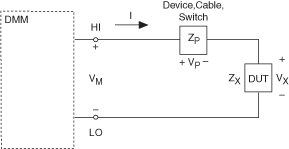Residual Impedance
For the NI 4072 only, Impedance is a measure of opposition to the flow of alternating currents. Residual impedances, which are found in series between the DMM and the DUT, result from the connectivity required between the DMM and the DUT. The residual impedance on the test application introduces an error by dividing the voltage across the DUT. This error can affect the accuracy for inductance and capacitance measurements, particularly when the residual impedance is comparable to the impedance of the DUT. The following figure illustrates residual impedance in a typical measurement.

where
ZP = residual impedance
ZX = impedance of the DUT
VM = total input voltage measured by the DMM
VP = voltage drop across total residual impedance
VX = voltage across DUT
VM = VP + VX
ZM = VM/I = VP/I + VX/I = ZP + ZX
 |
Note Bold values denote vector quantities or complex numbers. |
For example, in an application with a 10 uH inductor in series with a 1 uH cable, the meter reads a 10% error, or 11 uH (10 uH + 1 uH).
To reduce residual impedances on test fixtures and cables, take the following steps:
- Keep the cables as short as possible.
- Avoid any variations due to mechanical vibrations, handling, and temperature changes.
- Use the compensation techniques available on the NI 4072. Refer to OPEN/SHORT Compensation for more information.
In addition to residual impedance, stray admittances can also be found in test setups. Refer to Stray Admittance for more information.